Astronomy -Trail Magazine N.1 (10 topics)
Welcome to the Astronomy-Trail Magazine N-1, the aim is to showcase some of my best topics for today , to promote use of the #astronomy tag and to promote a community where writers, researchers, educators and students can interact and exchange ideas.
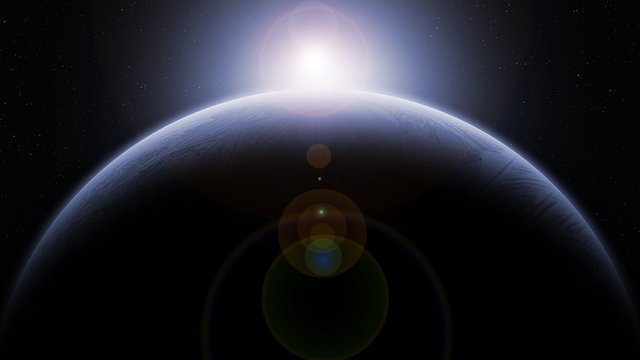
I Hope you enjoy the selection of articles below.
Topic N.1-Everything you need to know about our galaxy, the Milky Way.
We all live in the same world, the Earth, which inscribes itself in a clearly defined system, but taking a little of perspective, we could see that our planet and our system are part of a much broader and more complex structure, from the earliest prehistoric times, human have wondered about this mysterious milky strip lining the night sky. It is only with the birth of modern astronomy that scientists have seen these countless stars at considerable distances from Earth.
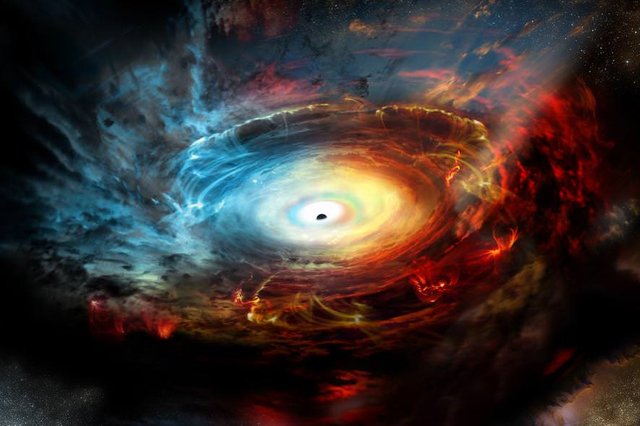
The term "Milky Way" emerged in classical antiquity to describe the strip of light in the night sky and has since become the name of our galaxy. Like many others in the known universe, the Milky Way is a barred spiral galaxy that is part of a local group - a collection of 54 galaxies, measuring 100,000 to 180,000 light-years in diameter for about 1,000 light-years thick, it is now estimated that the Milky Way comprises between 100 and 400 billion stars. It is difficult to make an exact estimate. Our galaxy is constantly evolving with millions of stars that are born and explode.
At the physical level, the Milky Way consists of a center and a galactic disc consisting of spiral arms, all surrounded by a halo of old stars and globular clusters. The Center, also known as "bulge", is a dense concentration of predominantly old stars that measures about 10,000 light years in the radius, this region is also the center of rotation of the Milky Way. The Galactic Center is also home to an intense radio source called Sagittarius A, probably a supermassive black hole. The presence of this black hole is discerned due to the apparent gravitational influence on the surrounding stars. This would have a mass between 4.1 and 4.5 million solar masses.
Around the galactic center, you will find the four spiral arms of the galaxy (two big arms and two smaller ones, although there is no consensus on the exact structure or extent of these arms yet). These contain a higher density of interstellar gases and dust than the galactic average, as well as a higher concentration of star formation. Our system is located in the so-called "Orion" arm at about 28,000 light-years from the galactic center, mainly composed of red (older) stars, this arm would circle the galaxy in 250 million years, since its formation, about 4.5 billion years ago, our system would have already carried out between 20 and 21 galactic revolutions.
Finally, you can not feel it, but our planet orbits around the Sun at a speed of about 100,000 km / h. What we could even less feel is that the Galaxy itself moves through space at the phenomenal speed of 2 million km / h, or about 630 km per second, driven by a supercluster Located some 600 light-years away and pushed by a vast galactic region of very low density.
Topic N.2-A celestial light called Steve.
Is it an aurora borealis? No, it's Steve. It is the very little poetic name that has been given to a mysterious "ribbon" of light that runs over the Canadian Far North, from the Pacific to Hudson Bay.
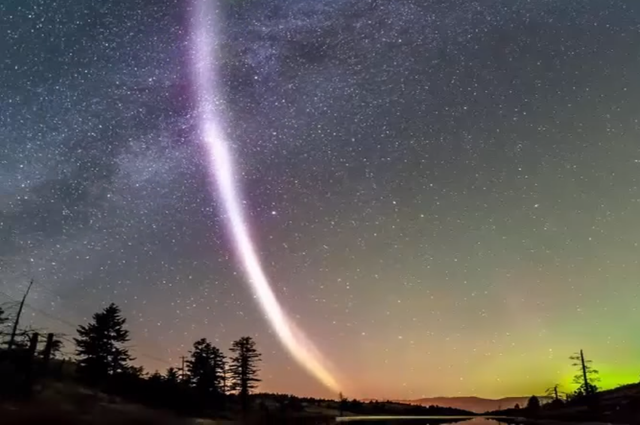
Scientists have trouble defining what it is, hence the provisional name of Steve, but its discovery delights the amateurs of "citizen science": it is indeed Canadians amateurs of aurora borealis, gathered around a Facebook group, who began a few years ago to share photos of these "lights" Very diffuse - which were not like the others, and so, the scientists began to take an interest in it. It is known today that it is a "ribbon" of ionized gas about 25 km wide, whose temperature can reach 6000 degrees Celsius, and which moves about 8 kilometers per second, from east to west. It has been duly analyzed and documented, particularly in 2016, due to the three European SWARM satellites - but we still don't know why it is there.
Topic N.3-Gliese 1132b: an atmosphere, but of what?
The European astronomers announced : the detection of an atmosphere around a planet about the size of the Earth - one and a half times its size, this planet revolves around the star Gliese 1132b (or GJ 1132b), located 39 light-years away.
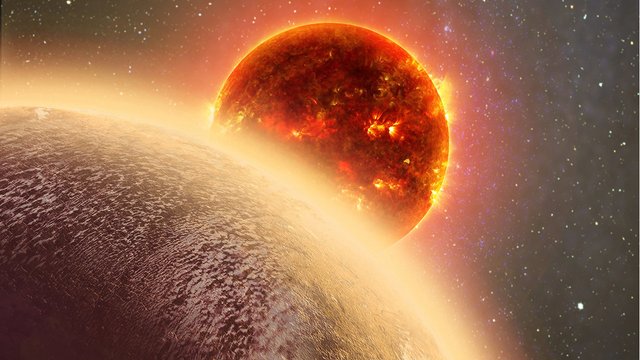
But there is a big chunk in the puzzle: we have no idea what makes up this atmosphere, detection consists of a very fine analysis of the "transit" data, that is, the moment when the planet passes exactly between its star and us, this passage makes it possible to evaluate the size and the mass of the planet and - this is the first - the tiny variation in light also allowed astrophysicists to conclude that an atmosphere was present, but this is an indirect detection: one can 't see this atmosphere, let alone analyze its composition. All the scenarios that surrounded this discovery - it could be a habitable planet, it could shelter an ocean...
Topic N.4- Citizen science in search of the 9th planet.
More than 60,000 people around the world have peeled hundreds of thousands photos from the skies of the southern hemisphere, looking for the hypothetical ninth planet that may turn beyond Neptune, an effort of citizen science that allowed to isolate four "candidates".
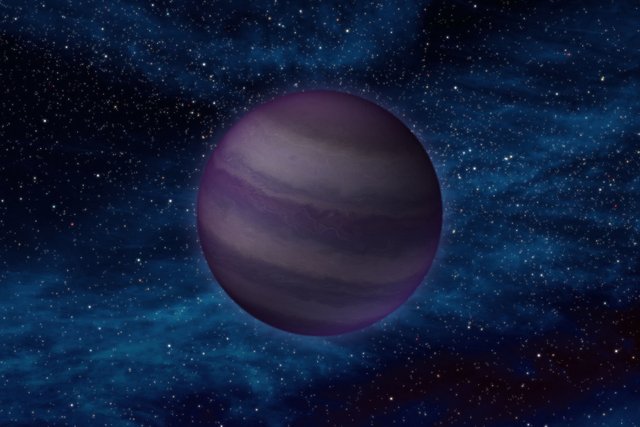
The Planet 9 Search project was launched by the Australian National University. It allowed "to complete four years of scientific analyzes in three days", summarizes the astronomer Brad Tucker in a statement, four million objects had to be identified one by one on these hundreds of thousands photos, in search of objects that do not already appear in cosmic catalogs. The all-time record-breaking enthusiast is named Toby Roberts, who alone ranked 12,000 items.
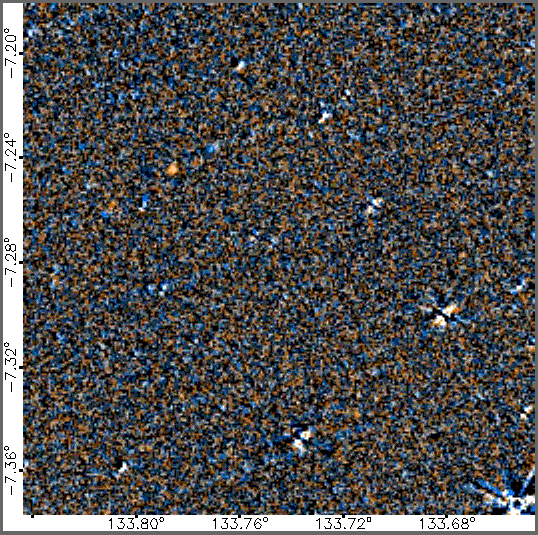
- A brown dwarf named WISE 0855? 0714 appears as an orange dot in this series of images (taken over a five-year period). By examining films like this, citizens can help discover more objects.
Astronomers will now set aside time on the telescopes to take a closer look at these four candidates, but whether it is a planet or not, collaborative work has already eliminated the possibility that, At the edge of our solar system, a planet the size of Neptune in 90% of the sky of the southern hemisphere.
Topic N.5- Earth in space: 70 years of pictures.
Seventy years ago, mankind was looking for the first time from space.
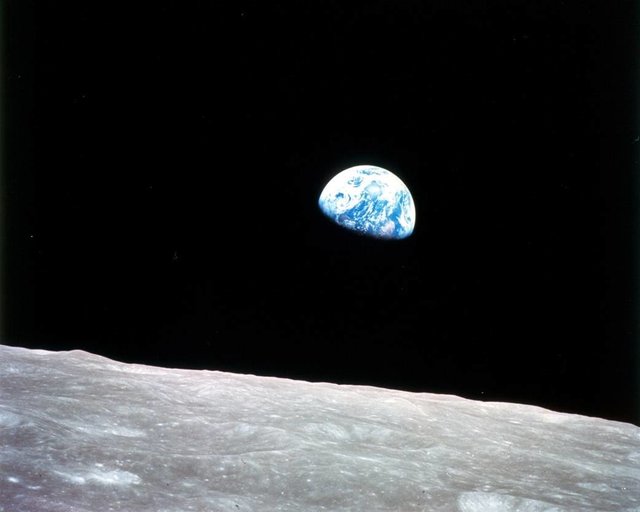
It wasn't yet the picture of an "Earthrise" above the lunar landscape that the astronauts of Apollo 8 were going to take in 1968, but at the end of 1946 and at the beginning of 1947, the first rockets American experimentalists had crossed the altitude of 100 km: the symbolic limit of space, and above all, they had taken the opportunity, for the first time, photographs - fuzzy and black and white - on which appeared the curvature of our planet. In an interview last fall at Air & Space magazine, a member of the recovery team of the first rocket was amusingly telling that when the photos had finally been developed, "scientists had gone mad."
A video montage of the magazine Nature, Portraits of a Planet: Earth from Space, brings together these images that have changed the perception of our world - and have spawned the environmental movement.
<iframe width="992" height="558" src="
Topic N.6 -The core of our star rotates 4 times faster than its surface.
Researchers have for the first time accurately measured the rotation of the solar core. They revealed that it doesn't rotate at the same speed as the surface, but almost four times faster.
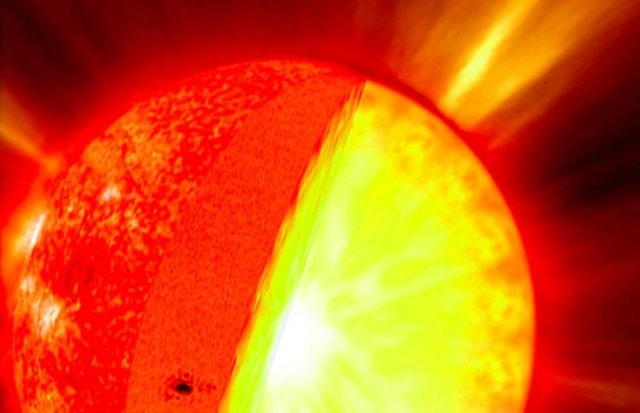
The more our instruments are refined and the more we learn about our stars. Although the researchers have already considered the possibility that the rotation of the Sun's nucleus may not keep pace with its external face, they have until now no way of knowing it with certainty and many have assumed that everything The Sun was finally one and the same merry-go-round. New research confirms, that this is not the case, the core of the sun rotates about four times faster than the surface, better yet, this basic rotation could teach us more about the crazy youth of our star.
The rotation of the solar core can indeed give us an idea of how the sun has formed. "The most probable explanation is that this basic rotation has remained the same as the formation of our star, about 4.6 billion years ago," explains Roger Ulrich, professor emeritus of astronomy and Co-author of the study in the journal Astronomy and Astrophysics. "It's a surprise, and it's really exciting to imagine an example of what the sun was like in its early days." a few million years after its formation, the solar wind probably slowed the rotation of the outer part of the sun.
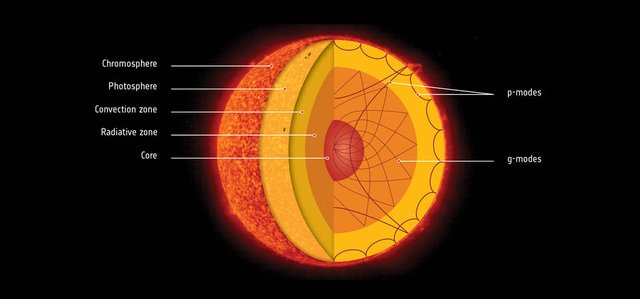
Due to the data provided by ESA and the NASA Solar and Heliospheric Observatory, researchers have been able to study surface acoustic waves in the atmosphere of the sun, some of which enter the nucleus where they interact with Of gravity waves, by carefully measuring the acoustic waves, the researchers then determined precisely the time taken by an acoustic wave to move from the surface to the center of the sun and then return again, the travel time translates into a slight decrease in the motion of the gravity waves.
As for the nucleus, let us remember that it represents about 20 to 25% of the solar ray and that it constitutes approximately 10% of the mass of the Sun, Its temperature is approaching 15,000,000 Kelvin, which is the hottest temperature in the Solar System. This high temperature is caused by the nuclear fusion of hydrogen which results in the subsequent creation of helium and the release of visible light at the surface, the surface temperature is only 5,800 Kelvin.
Topic N.7-Neil DeGrasse Tyson doesn't think we're alone in the universe.
We are probably not alone in the universe and the extraterrestrials probably exist according to one of the most famous and most respected astrophysicists in the world.
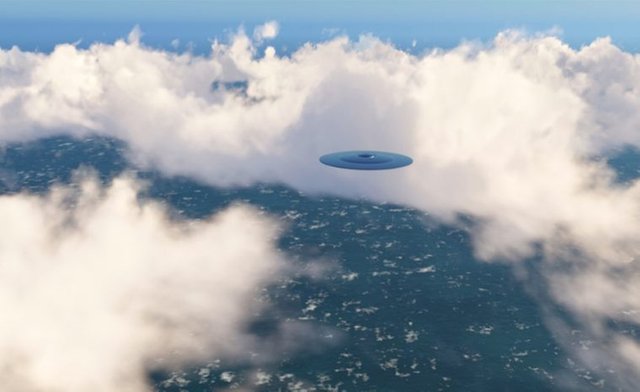
Neil deGrasse Tyson is director of the Hayden Planetarium at the American Museum of Natural History in New York. He is also one of the most popular American astrophysicists and a renowned popularizer often regarded as the heir of Carl Sagan, a man he venerates, an asteroid carries its name: the asteroid (13 123) Tyson. Recently asked about C-SPAN, a network of three cable channels devoted to continuous and direct coverage of government interventions and the dissemination of programs concerning public affairs, the astrophysicist spoke on the chemistry of living things , Considering that it was highly unlikely that the Earth would be the only place in the universe where life would have developed.
"Earth is not uncommon or unique," he explains, "because the carbon chemistry on which life depends is the most fertile chemistry possible, and carbon is abundant across the universe. " The astrophysicist on the other hand on a microbial rather than intelligent life, In this spirit, human explains not to believe in the testimonies that refer to the "strangers" who visit the Earth. Neil deGrasse Tyson, who is presenting the excellent Cosmos series on Netflix on the way, spoke on the subject a few weeks ago on Reddit in "Ask Me Anything", a section of the forum dedicated to questions / answers with a speaker. Invited on the discussion forum, the famous astrophysicist Neil deGrasse Tyson had indeed explained the fact that he didn't think that human would come into contact with complex organisms in the next fifty years.
"No," he said. "I think they are (and we are) too far apart in space and probably also temporally, by complex, I presume you are referring to other unicellular life forms, life with legs, arms, thoughts, etc. This will depend on our ability to travel interstellar distances, and this will surely not happen in the next fifty years. Not at the speed at which things are now ".
So, are we alone in the Universe? No, probably not according to the researcher. Are we the only intelligent species? No idea and we may never know, at least not in our lifetime.
<iframe width="662" height="372" src="
Topic N.8 -The mystery of the "luminous nights" finally elucidated.
The phenomenon of "luminous nights" (characterized by an inexplicably clear night sky) has long left scientists perplexed and unable to explain why the sky was illuminating abnormally. The mystery has just been resolved.
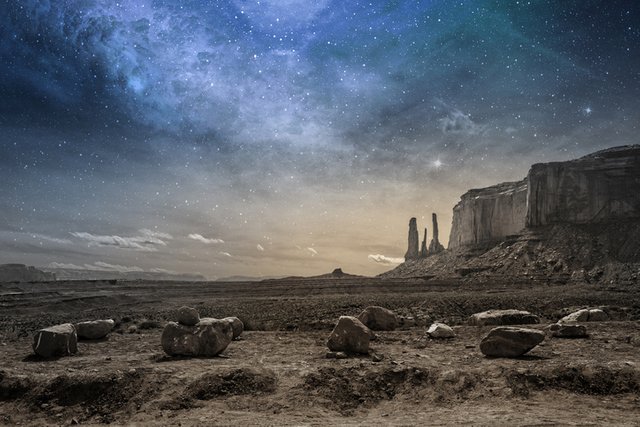
If you are not familiar with this strange mystery of "bright nights", do not panic. These nights have always been rare events and even more today because of the effects of light pollution on the night sky. Imagine then on your terrace, at night, able to read your newspaper as the sky is clear, observation reports like these, dating from ancient Rome, have long left scientists and spectators perplexed, unable to find a "logical" explanation for these exceptionally "clear" nights, Due to a Canadian team based on satellite data, this is now done.
In a study published this in Geophysical Research Letters, Gordon Shepherd and his colleague Young-Min Cho suggest that the phenomenon would result from peaks in air glow - or from night sky lights - that correspond to low The Earth's atmosphere, the appearance of such peaks would be due to the Rossby waves, these undulatory and planetary air movements in the upper atmosphere.
The green part of the night sky light occurs when sunlight in the upper atmosphere separates molecular oxygen into individual oxygen atoms. When atoms recombine, they eliminate excess energy as photons in the green part of the spectrum of visible light by giving a greenish tinge to the sky. The researchers then associated these events with the increase and decrease of the zonal waves (Rossby wave). These waves are influenced by the weather on the surface of the Earth and move around the upper atmosphere. When wave peaks line up, they produce phenomena that are four to ten times brighter at certain points of the globe than during classic nocturnal periods, and can spread over several nights.
According to the data collected by the team, a "light night" would occur somewhere on earth on average about 7% of the nights. Its observation, however, would be conditioned by being placed in a place isolated from all light pollution, under a clear sky and without a moon. Thus it might be possible to predict one of these "luminous nights" by watching the Rossby waves and aligning their peaks, these nights sometimes being detrimental to astronomers observations.
Topic N.9- Stephen Hawking: "I am convinced that humans will need to leave the earth"
Stephen Hawking is convinced that the future of human is not on Earth, but in space. For him, it is even the only solution to ensure the survival of our species.
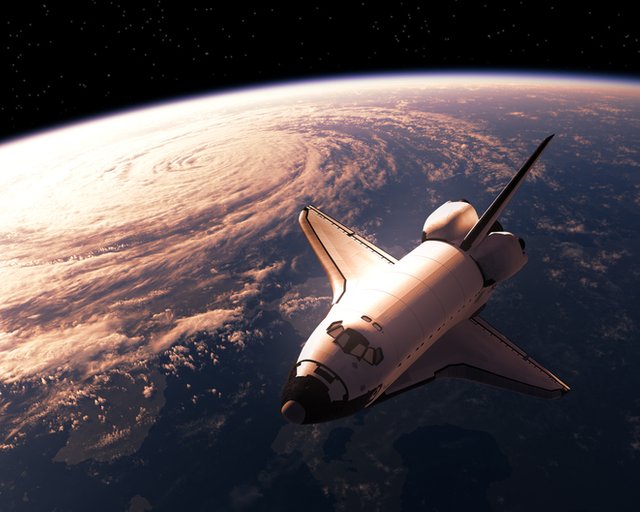
The Starmus Festival in Trondheim, Norway, is an international gathering focused on all issues related to astronomy. The illustrious scientist Stephen Hawking took advantage to speak on the future of our species. The human is persuaded: "We lack space and the only places to go are the other worlds. [...] I am convinced that humans must leave Earth". For the physicist, we lack and will lack more space, and we don't have enough natural resources to meet our needs. So we'll have to leave.
Going to agreement, but where? Stephen Hawking recently called on governments to join forces to build a lunar base in the next three decades. A launching ramp, since the main objective remains Mars. He proposes to send human on the spot by 2025 to prepare for the future, not exploration, but colonization of the red planet. In this sense, various plans have already been devised, both by governmental space agencies and private companies, for example, NASA notes that the establishment of an orbital lunar station would be a key step for a future mission on the red planet. Other nations are also working with the same goal: China, Europe and other countries are also preparing to set up their own lunar bases. A kind of "Cold War Space", except that now there are more nations involved.
The physicist hopes nevertheless that the union will make by force, and that the human will agree to a common objective. In addition, Hawking also believes that these programs will have beneficial effects on the younger and the next generations who will need more. "An ambitious new program would excite (young people) and stimulate their interest in other fields such as astrophysics and cosmology," he explains. Moreover, these missions could contribute to the creation of a true scientific emulsion and perhaps even give rise to major technological innovations.
Topic N.10-These seeds could seed the Universe.
Two biologists claim that the flower called Morning Glory, a climbing plant close to volubilis found in southern Mexico, Guatemala and the West Indies, could spread life in the Universe.
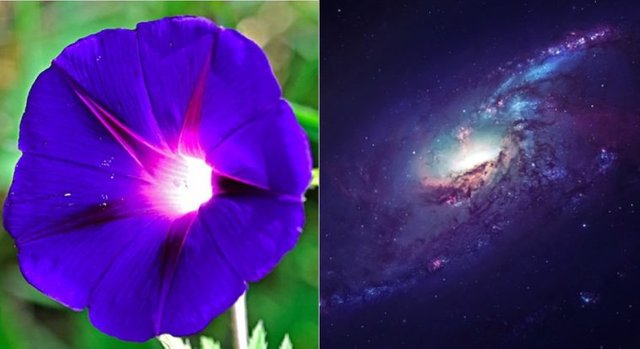
How did life appear on Earth? Many theories are advanced. One of them, "panspermia", suggests that life would come from space. The theory of panspermia suggests that life would propagate in interstellar space in the form of germs or spores propelled by the pressures of light. Some then imagine these "seeds" of life hanging from meteorites coming down on Earth, burying our planet about 3.5 billion years ago. Those who refute the hypothesis put forward the idea that these "germs" could not survive the conditions of space (very violent), yet, according to a recent study, these "morning glory seeds" could survive ultraviolet radiation at levels up to 6 million times used to sterilize drinking water on Earth.
"We don't claim that life comes from space," says David Tepfer of the Palais de Versailles Research Center, "On the other hand, we assure the resistance of these seeds to the conditions operating in deep space, which makes the hypothesis of panspermia more plausible." The other seeds involved in the experiments were burnt. Thus the seeds of the Morning Glory have special properties that make them more robust, the plants were actually successfully grown from these seeds even after the radiological dam. These seeds are known to be wrapped in very thick layers and can survive decades in the soil before germinating. That's why they were chosen for the study published in the site Astrobiology.
The study is therefore promising, but also has its limitations. Indeed, it will now be necessary to re-examine the experience directly in space. If the results were to be confirmed, that is, if life as such could indeed find its way into deep space, then it would be possible on the one hand that life on Earth should come, and that organizations can travel from one planet to another.
It would therefore be possible for human to sow an exoplanet. "Imagine that dormant seeds are being sent to different planets to release microbial life or the building blocks of life," says David Tepfer. " As a human we have to stay on Earth and clean up our mess, but over the next few years our technologically competent species could embrace its role as a life diffuser - using these seeds laden with microorganisms."
If you like this post or feel I am doing something wrong that needs to be corrected, drop a comment below and if you enjoy reading this don’t hesitate to upvote and resteem

Great article!